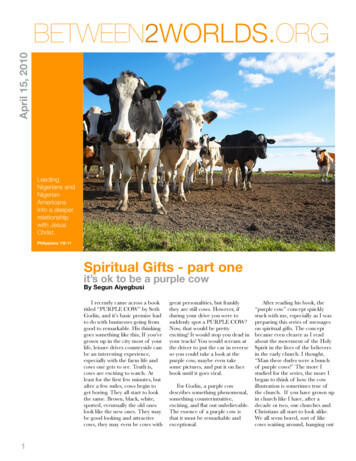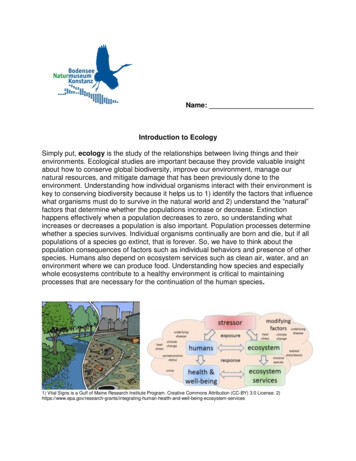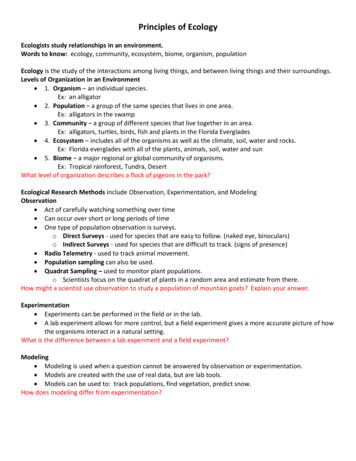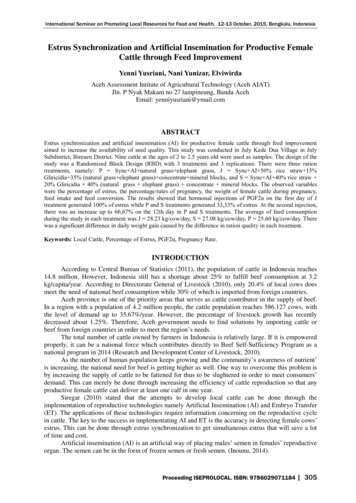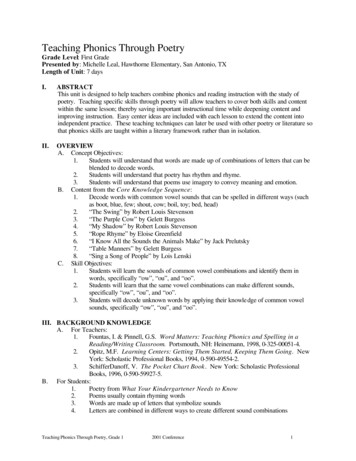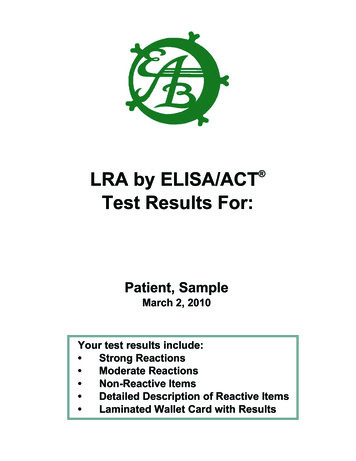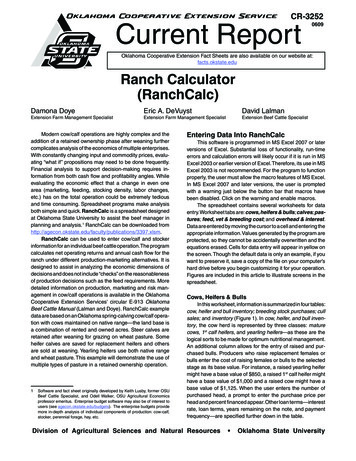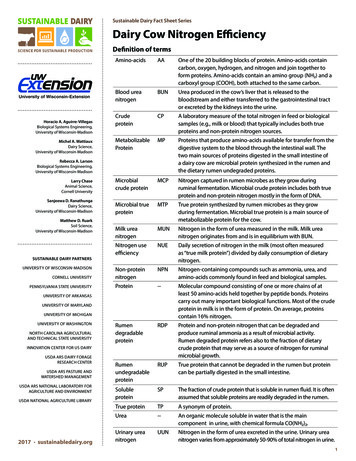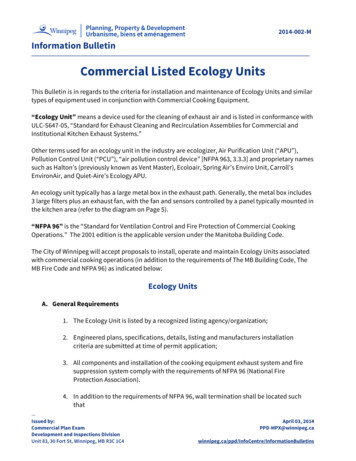
Transcription
2014-002-MInformation BulletinCommercial Listed Ecology UnitsThis Bulletin is in regards to the criteria for installation and maintenance of Ecology Units and similartypes of equipment used in conjunction with Commercial Cooking Equipment.“Ecology Unit” means a device used for the cleaning of exhaust air and is listed in conformance withULC-S647-05, “Standard for Exhaust Cleaning and Recirculation Assemblies for Commercial andInstitutional Kitchen Exhaust Systems.”Other terms used for an ecology unit in the industry are ecologizer, Air Purification Unit (“APU”),Pollution Control Unit (“PCU”), “air pollution control device” [NFPA 963, 3.3.3] and proprietary namessuch as Halton’s (previously known as Vent Master), Ecoloair, Spring Air’s Enviro Unit, Carroll’sEnvironAir, and Quiet-Aire’s Ecology APU.An ecology unit typically has a large metal box in the exhaust path. Generally, the metal box includes3 large filters plus an exhaust fan, with the fan and sensors controlled by a panel typically mounted inthe kitchen area (refer to the diagram on Page 5).“NFPA 96” is the “Standard for Ventilation Control and Fire Protection of Commercial CookingOperations.” The 2001 edition is the applicable version under the Manitoba Building Code.The City of Winnipeg will accept proposals to install, operate and maintain Ecology Units associatedwith commercial cooking operations (in addition to the requirements of The MB Building Code, TheMB Fire Code and NFPA 96) as indicated below:Ecology UnitsA. General Requirements1. The Ecology Unit is listed by a recognized listing agency/organization;2. Engineered plans, specifications, details, listing and manufacturers installationcriteria are submitted at time of permit application;3. All components and installation of the cooking equipment exhaust system and firesuppression system comply with the requirements of NFPA 96 (National FireProtection Association).4. In addition to the requirements of NFPA 96, wall termination shall be located suchthat—Issued by:Commercial Plan ExamDevelopment and Inspections DivisionUnit 83, 30 Fort St, Winnipeg, MB R3C 1C4April 03, InformationBulletins
April 03, 2014Information Bulletin2014-002-MPage 2 of 5a) a concentrated stream of air will not discharge directly onto pedestrians,b) discharged exhaust will not accumulate in an area with outdoor seating, andc) the sound pressure level generated must be attenuated to be in compliancewith the Neighbourhood Liveability By-law.5. The termination shall be designed to the satisfaction, review and approval of theAuthority Having Jurisdiction.6. Where there is a canopy, the discharge should be located above the canopy.7. The exhaust and make-up air locations should be determined respectful of existingdischarge, make-up air, operable window, and door locations of neighbouringproperties.8. In some cases, the Authority Having Jurisdiction may not approve exhaust or make-upair wall terminations on street frontages.9. Wall terminations should be located where they have the least impact on nearbyproperties, suites, amenity areas, the public realm, windows, and building design.a) Roof terminations are preferred and wall terminations should be locatedtowards the lane.b) Where an ecology unit is provided, a wall termination is permitted right up tothe lane property line or street property line.c) The preferred location for horizontal discharge is to a lane.B. No Downgraded DuctworkDowngrading of the ductwork after an ecology unit is not allowed per the following NFPA 96excerpt:96. NFPA 96, 9.3:“.air pollution control devices [i.e., ecology units], or other devices shall be permitted to beinstalled in ducts. Downgrading other parts of the exhaust system due to the installation ofthese approved devices, whether listed or not, shall not be allowed.All ductwork to, from point or origin (cooking equipment) to Ecology Unit and from theEcology Unit to the outside point of discharge shall comply with the requirements of NFPA 96—Commercial Listed Ecology ns
April 03, 20142014-002-MInformation BulletinPage 3 of 5(duct construction, materials and installation).Kitchen systems complying with the NFPA 96 standard typically have components of weldedsteel liquid tight seamless ductwork, a heavy duty stainless steel exhaust hood, a firesuppression system underneath the hood and a make-up air system.C. Access Panels after Ecology UnitAll required access panels shall comply with the requirements of NFPA 96 and in addition:a. Any buildup of grease in the ductwork downstream of an ecology unit is required to becleaned by a qualified kitchen exhaust cleaner and access panels necessary for thiscleaning are required to be installed on all systems.b. Access panels necessary for servicing the fire suppression nozzles downstream of anecology unit are required to be installed on all systems.D. Fan Continues RunningIf the hood exhaust fan is running when the fire suppression underneath the hood activates,the exhaust fan is required to continue running. [NFPA 96 8.2.3, NFPA 17A]An ecology unit fan is similarly required to continue running so that the fire suppressiondischarge in the ductwork is drawn up the ductwork to suppress the fire. The motor overloadprotection device in an ecology unit may automatically stop the fan if the absolute filterbecomes plugged.E. No Enzyme Odour ControlOdour control by means of enzymes is not permitted.F. Maintenance of Ecology UnitsRegular inspection, cleaning, filter changes (i.e., “grease removal devices”) and maintenanceshall be required for all cooking exhaust systems and systems where Ecology Units have beeninstalled.A regular maintenance and inspection program is to be established and accuratemaintenance and inspection records shall be maintained and available to the AuthorityHaving Jurisdiction (e.g. Provincial Health Inspector, City of Winnipeg Fire PreventionOfficer).—Commercial Listed Ecology ns
April 03, 2014Information Bulletin2014-002-MPage 4 of 5Hoods, ducts and filters subject to accumulations of combustible deposits shall be inspectedat intervals not greater than thirty (30) days, and shall be cleaned if the accumulation ofsuch deposits creates a health and/or fire hazard.Only qualified personnel are permitted to test or inspect a cooking equipment fire protectionsystem on the intake and discharge sides of an Ecology Unit.Filter shall be listed, for both original and replacement, and shall be properly installed, cleanand free of damage.Filters in an Ecology Unit are required to be changed on a regular basis in order to maintainminimum airflows and proper air-cleaning operation of the Ecology Unit.Filters are to be changed at frequencies as required by the Ecology Unit manufacturer and theCity By-laws.Filter changes may be done by the owner, or the owner’s staff, in accordance with themanufacturer’s recommendations, or by a maintenance company certified by themanufacturer.Cleaning of hoods, grease removal devices, fans, ducts, and other appurtenances shall becleaned at frequent intervals to prevent surfaces from becoming heavily contaminated withgrease or other residues. It is recommended that exhaust systems should be cleaned at intervals not greaterthan 12 months, but in the case of deep fat cooking, char broiling or similar cookingoperations, the systems should be cleaned at intervals not greater than 3 months.Maintenance and repairs shall be performed on all components at intervals necessary tomaintain these conditions such as, but not limited to, minimum airflows and good workingcondition of all components. [NFPA 96, 4.1.5]Maintenance Log Records shall be kept up-to-date and be available for review at times ofinspection conducted by government inspectors.—Commercial Listed Ecology ns
April 03, 20142014-002-MInformation BulletinPage 5 of 514th FLOORTermination of cooking exhaust tocomply with the requirements ofNFPA 96ROOF2nd FLOORNFPA 96 DuctMultiple Rows of Listed FiltersListed Fire DamperAccess PanelsAccess PanelsLISTED ECOLOGY UNITNFPA 96 Exhaust CanopyExhaust FanTo comply with allMB Building CodeMB FIRE CODE andNFPA 96 RequirementsCooking Equipment—Commercial Listed Ecology ns
Having Jurisdiction (e.g. Provincial Health Inspector, City of Winnipeg Fire Prevention Officer). Kitchen systems complying with the NFPA 96 standard typically have components of welded steel liquid tight seamless ductwork, a heavy duty stainless steel exhaust hood, a fire suppression system underneath the hood and a make -up air system.
